- News
- Reviews
- Bikes
- Accessories
- Accessories - misc
- Computer mounts
- Bags
- Bar ends
- Bike bags & cases
- Bottle cages
- Bottles
- Cameras
- Car racks
- Child seats
- Computers
- Glasses
- GPS units
- Helmets
- Lights - front
- Lights - rear
- Lights - sets
- Locks
- Mirrors
- Mudguards
- Racks
- Pumps & CO2 inflators
- Puncture kits
- Reflectives
- Smart watches
- Stands and racks
- Trailers
- Clothing
- Components
- Bar tape & grips
- Bottom brackets
- Brake & gear cables
- Brake & STI levers
- Brake pads & spares
- Brakes
- Cassettes & freewheels
- Chains
- Chainsets & chainrings
- Derailleurs - front
- Derailleurs - rear
- Forks
- Gear levers & shifters
- Groupsets
- Handlebars & extensions
- Headsets
- Hubs
- Inner tubes
- Pedals
- Quick releases & skewers
- Saddles
- Seatposts
- Stems
- Wheels
- Tyres
- Health, fitness and nutrition
- Tools and workshop
- Miscellaneous
- Buyers Guides
- Features
- Forum
- Recommends
- Podcast
TECH NEWS
Tour Tech 2018: Trek-Segafredo’s Trek Madone SLR Disc + video
This is the brand new Trek Madone SLR Discs that’s currently being ridden in the Tour de France by Trek-Segafredo's Bauke Mollema.
Trek announced a hugely updated Madone range a couple of weeks ago, with adjustable IsoSpeed (more on that in a mo), a new geometry and disc brake models. The rim brake version is lighter than the disc brake model, as it always is, and they're equally aerodynamically efficient, according to Trek.
The new Madone will be available in a top-end SLR version – which is what the pros ride – and in a slightly more accessible SL version.
Check out our story on the new Trek Madone here.
One of the most important new features is the adjustable IsoSpeed. Trek first brought in IsoSpeed on the Domane a few years ago and added it to the last incarnation of the Madone.
IsoSpeed is a design that “maintains the diamond-shaped frameset geometry but ‘decouples’ the seat tube from the top tube, allowing the seat tube to flex with the forces of the road” (Trek’s words). The idea is that it smooths the ride, adding comfort and reducing fatigue.
This time around Trek has brought in a what it calls Adjustable Compliance Technology. Adjustable IsoSpeed was first released on the seat tube of Trek’s Domane SLR.
“The Madone Adjustable Compliance Technology [comprises] two frame elements integrated into each other just like the Domane SLR, but has been rotated into the top tube for aerodynamic advantage,” says Trek.
“The two frame elements are connected by the IsoSpeed decoupler and the bolted joint at the front. In between the two frame elements is a vacant space with an adjustment slider that can move along the entire path. The seatmast element utilises the IsoSpeed decoupler to transfer the aft deflection of the upper aero section of the seatmast to an upward deflection of the lower seatmast element.
“The vacant space allows the lower seatmast to deflect in the upward direction while the main frame top tube element remains independent from the lower seatmast. The slider contacts both the lower seatmast element and main frame top tube element to limit the upward deflection of the lower seatmast per the rider’s preference.
“If the slider is towards the front of the frame, a rider will experience more compliance because of the greater vacant space that allows the lower seatmast to deflect more. If the slider is near the back of the frame towards the IsoSpeed Decoupler, a rider will experience less compliance because the slider is inhibiting deflection in the vacant space in front of it.”
Did you get all that?
According to Trek’s figures, the new Madone is capable of both more compliance (+17%) and less compliance (-22%) than its predecessor, depending on where the slider is set.
The Madone SLR also features a damper to help control rebound of the seatmast. In other words, the speed at which the seat tube returns to its usual position after flexing is now regulated, the idea being to keep the ride feeling smoother and more stable.
“When the seatmast element is loaded during an impact event at the saddle, it creates counter clockwise rotation when viewed from the perspective of the driveside of the bike,” says Trek. “This motion unloads the damper slightly and prepares it for the rebound event. As the seatmast begins to rotate back, the damper is re-loaded, thus slowing the motion and absorbing the rebound energy.”
Trek says that it has focused massively on aerodynamic performance in the development of the new Madone, using both CFD (computational fluid dynamics) software and wind tunnel analysis to arrive at the final design, although that has had to be balanced against the addition of adjustable top tube IsoSpeed, a new geometry, updated components, the addition of disc brakes (on some models) and the desire to keep the weight low. In other words, Trek hasn’t gone after aerodynamics at all costs.
Trek’s aim was to maintain the aerodynamic drag performance of the 9 Series Madone (within 30g) across an averaged -12.5° to 12.5° yaw sweep, and it says that it has achieved this.
Whereas aerodynamics pulls a frame design towards narrow tubes, the need for stiffness and light weight pushes it in the opposite direction so there’s always going to be something of a balancing act there.
Trek says that its goal for the rim brake version of the Madone SLR was to reduce or maintain the weight of the 9 Series Madone (7.1kg) while adding several new features, and that the disc brake bike was assigned a target of 7.5kg. Trek says that it met these objectives.
The 9 Series Madone was available in two different geometries: low and stretched H1 and slightly more upright H2. The new Madone SLR comes in a single geometry called H1.5 which, as you'll have guessed, sits between the two. Frame stack (vertical distance from the centre of the bottom bracket to the top of the head tube), reach (horizontal distance between those two points) and head tube length have all been changed.
Most 9 Series Madone models came with a combined aero handlebar and stem but the Madone SLR features a two-piece system – still proprietary – with more stem options (90mm to 130mm lengths, and -7° and -14° angles), additional bar sizes (38cm to 44cm) and +/-5° of bar rotation.
Trek-Segafredo use Shimano Dura-Ace Di2 groupsets with a R9100-P power meter. Mollema’s bike is here fitted with 54/42-tooth chainrings.
Nearly everything else on the bike is from Bontrager, Trek’s in-house brand, including the carbon-railed Montrose Pro saddle, the Aeolus XXX 6 wheels, the XXX water bottle cages and the Blendr computer mount.
Check out our Bontrager Montrose Pro saddle review here.
The only exceptions are the Vitorria Corsa tubular tyres in a 25mm width. The disc brake version of the Madone SLR will take tyres up to 28mm wide.
For more info go to www.trekbikes.com.
Head to our special Tour de France Tech page for more info on the bikes and equipment being used in the world's biggest race.
Mat has been in cycling media since 1996, on titles including BikeRadar, Total Bike, Total Mountain Bike, What Mountain Bike and Mountain Biking UK, and he has been editor of 220 Triathlon and Cycling Plus. Mat has been road.cc technical editor for over a decade, testing bikes, fettling the latest kit, and trying out the most up-to-the-minute clothing. He has won his category in Ironman UK 70.3 and finished on the podium in both marathons he has run. Mat is a Cambridge graduate who did a post-grad in magazine journalism, and he is a winner of the Cycling Media Award for Specialist Online Writer. Now over 50, he's riding road and gravel bikes most days for fun and fitness rather than training for competitions.
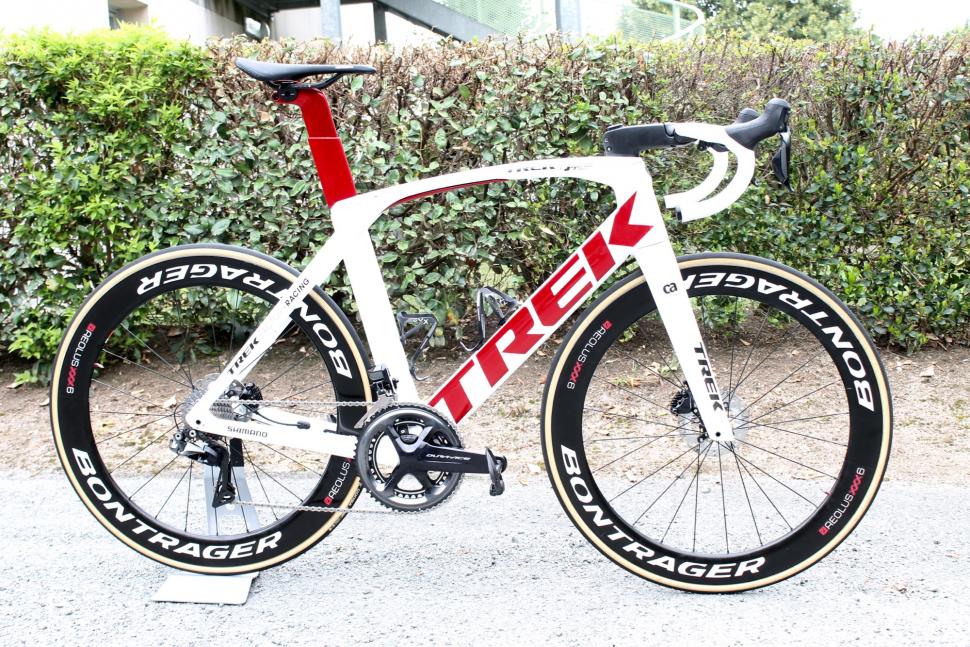

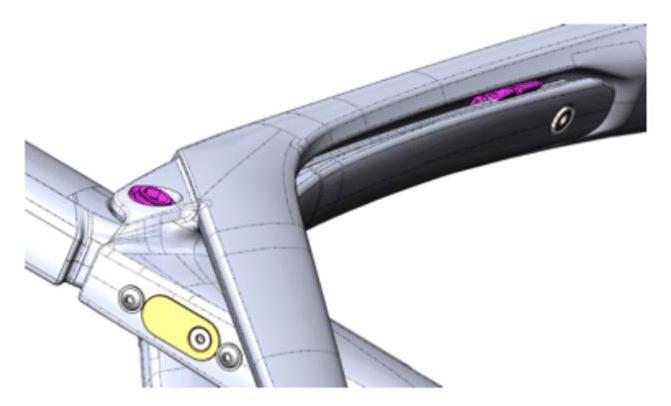
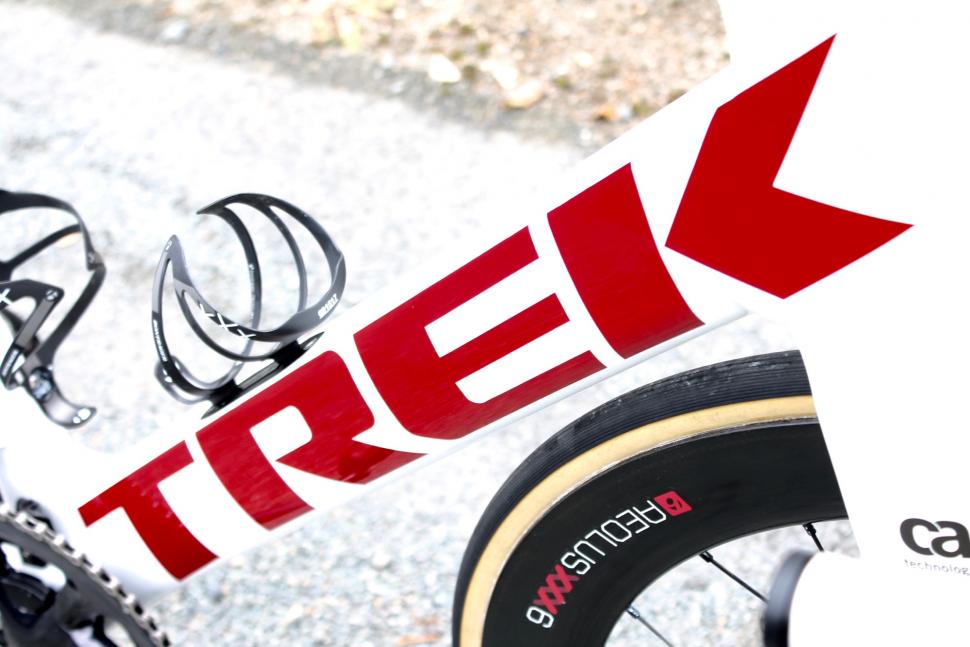

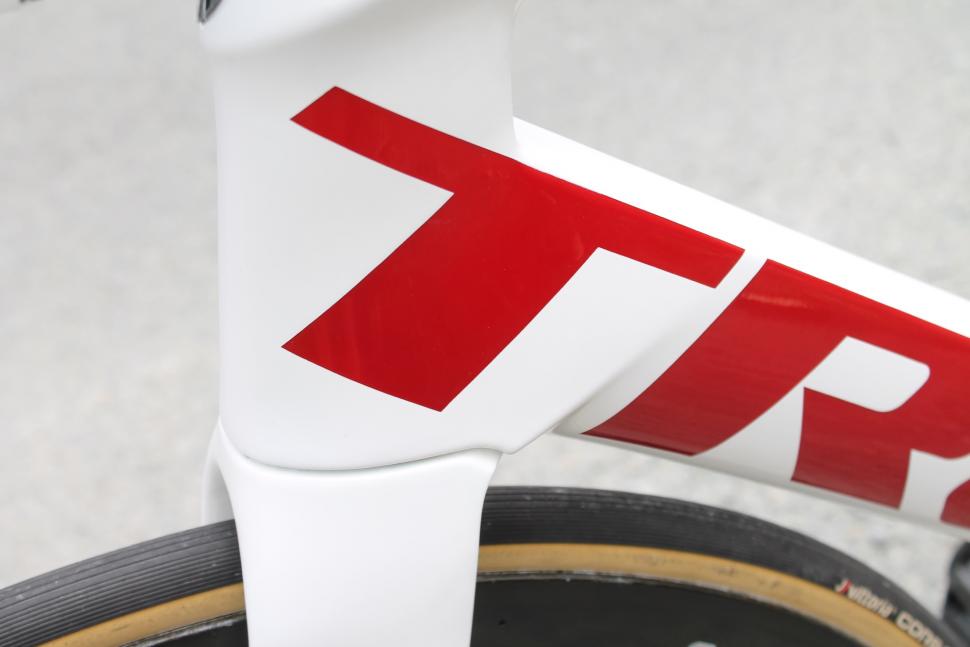

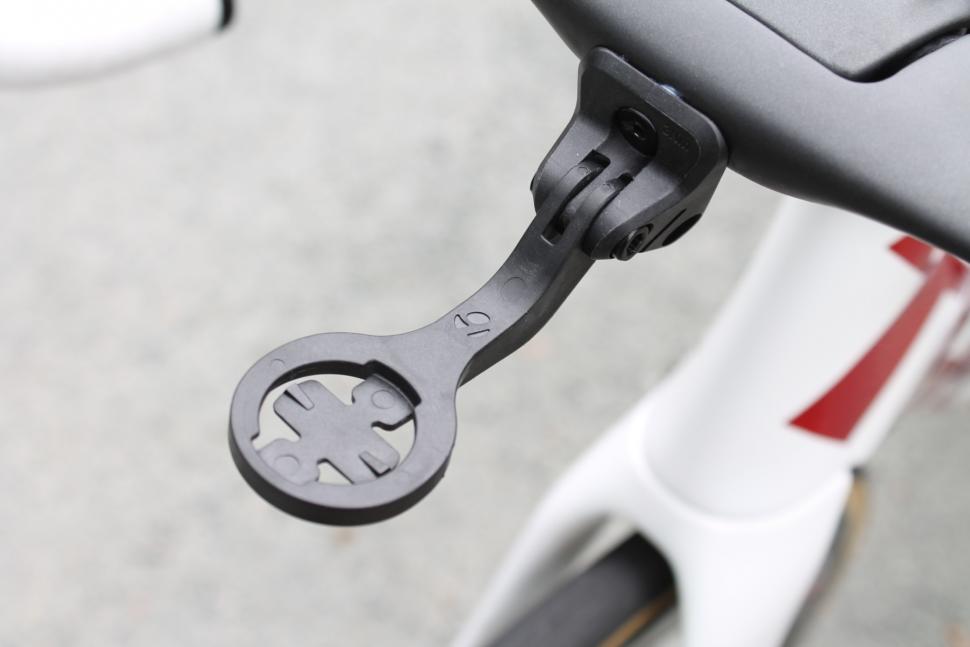

Here in Southampton we just get long lines of cars queuing for cruise ships. ...
Whilst EV cars are an improvement over ICE cars, I think they're a distraction from the possibilities of e-bikes, e-scooters and e-cargo-bikes etc....
I like how drivers make the case for making monitoring covert, not overt.
She seemed a bit upset about a minor misjudgement that could have killed someone and is going to cause months of stress and inconvenience.
No we don't agree, personally I would take primary, even if only for a short period although I can understand why some riders might not want to...
And which looks very like the bag produced by indy bag manufacturer Wizard Works…...
If it was a 'no vehicles' sign (all white circle centre), it would mean cyclists could ride in the hours that HGVs and disabled drivers are allowed...
The bit at the start and end looks like a cycle lane, but the bit they drive on looks just like a patched filter lane for traffic lights.
Hey, you 4 execs helped run a company into the ground and have no jobs anymore... Come work for us because you have great experience in the...
£11.5k for a bike weighing over 8kg that's 2 fingers to customers let alone UCI